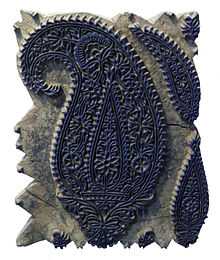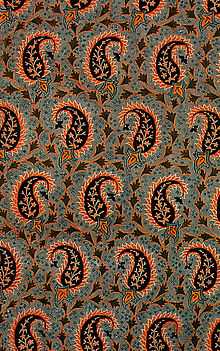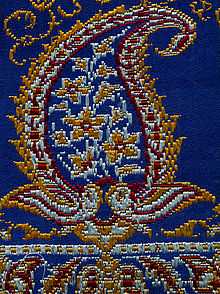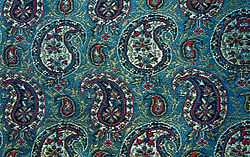Paisley (design)





Paisley or Paisley pattern is a term in English for a design using the boteh or buta, a droplet-shaped vegetable motif of Persian origin. Such designs became very popular in the West in the 18th and 19th centuries, following imports of post-Mughal versions of the design from India, especially in the form of Kashmir shawls, and were then imitated locally. The pattern is sometimes called "Persian pickles" by American traditionalists, especially quilt-makers,[1] or "Welsh pears" in Welsh textiles as far back as 1888.[2]
Origins
Resembling a twisted teardrop, the kidney-shaped paisley is of Iranian origin, but its western name derives from the town of Paisley, in West Scotland, a centre for textiles where paisley designs were produced.[3]
In Iran the design, known as Boteh Jegheh, has been used since the Sassanid Dynasty (AD 224 to AD 651).
Some design scholars believe it is the convergence of a stylized floral spray and a cypress tree: a Zoroastrian symbol of life and eternity.[4] (another name for the motif in Persian is sarv-e khamīdeh سرو خمیده, which literally means "curved cypress") A floral motif called Buteh,[5] which originated in the Sassanid Dynasty and later in the Safavid Dynasty of Persia (from 1501 to 1736), was a major textile pattern in Iran during the Qajar Dynasty and Pahlavi Dynasty. In these periods, the pattern was used to decorate royal regalia, crowns, and court garments, as well as textiles used by the general population. According to Azerbaijani historians, the design comes from ancient times of Zoroastrianism and is an expression of the essence of that religion. It subsequently became a decorative element widely used in Azerbaijani culture and architecture.[6]
The pattern is still popular in Iran and South and Central Asian countries. It is woven using gold or silver threads on silk or other high quality textiles for gifts, for weddings and special occasions. In Iran and Uzbekistan its use goes beyond clothing – paintings, jewelry, frescoes, curtains, tablecloths, quilts, carpets, garden landscaping, and pottery also sport the buta design. In Uzbekistan the most frequently found item featuring the design is the traditional doppi headdress.
In Tamil Nadu the manga maalai (mango necklace)[7][8] with matching earrings is a traditional feature of bharathanatyam dance.[9]
It is a prominent design in Kanchipuram saris.[10][11][12][13] It has sometimes been associated with Hinduism.[14][15]
In other languages
The modern French words for paisley are boteh and palme, the latter being a reference to the palm tree, which, along with the pine tree and the cypress tree, is one of the traditional botanical motifs thought to have influenced the shape of the paisley element as it is now known.[4][16]
In various languages of India and Pakistan, the design's name is related to the word for mango:
- In Bengali: Kalka[17]
- In Tamil: mankolam, mango pattern.
- In Marathi: koyari, mango seed.
- In Hindi/Urdu: carrey, mango seed.
- In Punjabi: ambi, from amb, mango.
In Chinese language it is known as "ham pattern" (火腿纹 huotuiwen).[18]
European introduction
Imports from the East India Company in the first half of the 17th century made paisley and other Indian patterns popular, and the Company was unable to import enough to meet the demand. It was popular in the Baltic states between 1700 and 1800 and was thought to be used as a protective charm to ward off evil demons.
Local manufacturers in Marseilles began to mass-produce the patterns via early textile printing processes at 1640. England, circa 1670, and Holland, in 1678, soon followed. This, in turn, provided Europe's weavers with more competition than they could bear, and the production and import of printed paisley was forbidden in France by royal decree from 1686 to 1759. However, enforcement near the end of that period was lax, and France had its own printed textile manufacturing industry in place as early at 1746 in some locales. Paisley was not the only design produced by French textile printers; the demand for paisley which created the industry there also made possible production of native patterns such as toile de Jouy.[19]
In the 19th century European production of paisley increased, particularly in the Scottish town from which the pattern takes its modern name. Soldiers returning from the colonies brought home cashmere wool shawls from India, and the East India Company imported more. The design was copied from the costly silk and wool Kashmir shawls and adapted first for use on handlooms, and, after 1820,[20] on Jacquard looms.
From roughly 1800 to 1850, the weavers of the town of Paisley in Renfrewshire, Scotland, became the foremost producers of these shawls. Unique additions to their hand-looms and Jacquard looms allowed them to work in five colors when most weavers were producing paisley using only two.[20] The design became known as the Paisley pattern. By 1860, Paisley could produce shawls with 15 colors, which was still only a quarter of the colors in the multicolor paisleys then still being imported from Kashmir.[20]
In addition to the loom-woven fabric, Paisley became a major site for the manufacture of printed cotton and wool in the 19th century, according to the Scotland's Paisley Museum and Art Gallery.[21] The paisley pattern was being printed, rather than woven, onto other textiles, including cotton squares which were the precursors of the modern bandanna. Printed paisley was cheaper than the costly woven paisley and this added to its popularity. The key places of printing paisley were Britain and the Alsace region of France.[22]
Contemporary style
Paisley was particularly popular during the Summer of Love, heavily identified with psychedelic style and the interest in Indian spirituality and culture brought about by the pilgrimage of The Beatles to India in 1968. Fender Guitars made a Pink Paisley version of their Telecaster guitar, by sticking paisley wallpaper onto the guitar bodies. Prince paid tribute to the rock and roll history of paisley when he created the Paisley Park Records recording label and established Paisley Park Studios, both named after his 1985 song "Paisley Park".
At the 2010 Winter Olympics, Azerbaijan's team sported colorful paisley trousers.[23] A Russian publication noted that "Azerbaijan has no chance of winning at the Winter Olympics; however, the country had already left its mark on the games".[24][25]
References
- ↑ Dallas, Sandra (1995), The Persian Pickle Club, St. Martin's Press, ISBN 0-312-13586-6.
- ↑ "Quilting and Patchwork", Good Housekeeping, 1983, ISBN 0-85223-276-4.
- ↑ English Dictionary, Oxford.
- ↑ 4.0 4.1 Indian Hand Woven Jacquard Jamavar Shawls, Zanzibar Trading.
- ↑ Campbell, Sophie (12 January 2007), "Paisley: a designer heritage", The Telegraph (UK).
- ↑ "Ковроткачество", Tourism (in Russian), AZ
- ↑ "22Kt gold Mango Mala necklace from India on Jewel of the Lotus". Asian art. Retrieved 2013-03-11.
- ↑ "Traditional Jewels of India". Jewels in India. Retrieved 2013-03-11.
- ↑ "Blue stones Mango Necklace Temple Bharatanatyam Jewelry". Vadaamalar. 2011-01-08. Retrieved 2013-03-11.
- ↑ Sarumathi, K (2012-08-12). "M.S. blue, mango motif still in vogue". The Hindu. Retrieved 2013-03-11.
- ↑ Trends, Desi (2012-06-15). "Jayapradha Red Kancheepuram Bridal Sari | Saree Blouse Patterns". Celebrity saree. Retrieved 2013-03-11.
- ↑ "Image 14620652". Kanchipuram Silk Saree Stock Photography. Dreams time. 2010-04-24. Retrieved 2013-03-11.
- ↑ "Sareeslook sarees". Picasa Web Albums. Google. 2009-11-13. Retrieved 2013-03-11.
- ↑ "Image of the Mankolam Design". Sacred Symbols of Hinduism. About. 2012-04-10. Retrieved 2013-03-11.
- ↑ "M", Hinduism Online Lexicon, Gutenberg
- ↑ B, Sharon (Aug 29, 2006), "Persian Pickles or Paisley?", Word press, retrieved February 3, 2008 Missing or empty
|title=(help). - ↑ Zaman Niaz, The Art of KANTHA Emroidery; (Second Revised Edition-1993), page-82;The University Press Limited,Dhaka,Bangladesh; ISBN 984-05-1228-5
- ↑ Baike, Baidu.
- ↑ "The Prohibition Years, 1686–1759", Le Musée de l'Impression sur Etoffes [The Museum of Printed Textiles], retrieved February 3, 2008.
- ↑ 20.0 20.1 20.2 Andrews, Meg, Beyond the Fringe: Shawls of Paisley Design, Victoriana, retrieved February 3, 2008. Heavily illustrated history of paisley fashions.
- ↑ "Paisley Museum and Art Gallery", About Britain.
- ↑ "Printed ‘Paisley’ in the 19th Century", Le Musée de l'Impression sur Etoffes [The Museum of Printed Textiles], retrieved February 3, 2008.
- ↑ "Vancouver 2010: The Olympics of the Silly Pants", Tonic.
- ↑ Азербайджан выиграл войну штанов (in Russian), AZ: Extra time
- ↑ "Психоделические" штаны азербайджанских спортсменов в Ванкувере (in Russian), AZ: Aze
Further reading
- Irwin, John (1973), The Kashmir Shawl, Victoria and Albert Museum, ISBN 0-11-290164-6.
- Levi-Strauss, Monique (1987), The French Shawls, Dryad, ISBN 0-85219-759-4.
- Reilly, Valerie (1987), The Paisley Pattern: The Official Illustrated History, Glasgow: Richard Drew, ISBN 0-87905-317-8.
External links
![]() Media related to Paisley pattern at Wikimedia Commons
Media related to Paisley pattern at Wikimedia Commons


.svg.png)